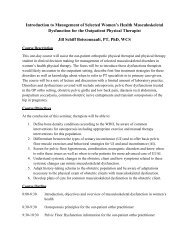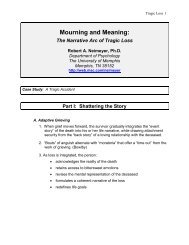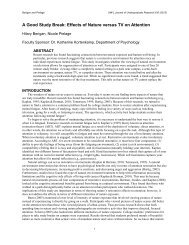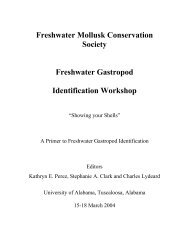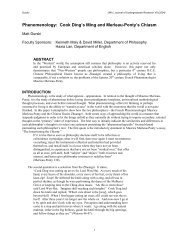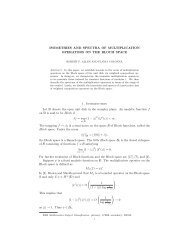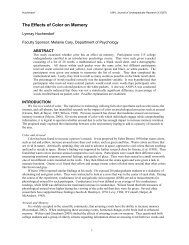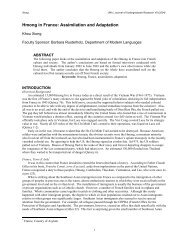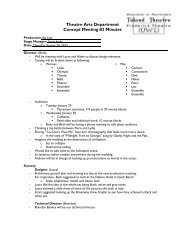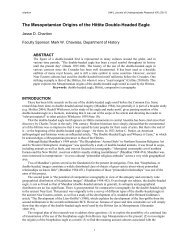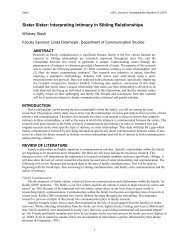Effects of The “What is Beautiful is Good” Stereotype on Perceived ...
Effects of The “What is Beautiful is Good” Stereotype on Perceived ...
Effects of The “What is Beautiful is Good” Stereotype on Perceived ...
Create successful ePaper yourself
Turn your PDF publications into a flip-book with our unique Google optimized e-Paper software.
Shinners UW-L Journal <str<strong>on</strong>g>of</str<strong>on</strong>g> Undergraduate Research XII (2009)<br />
<str<strong>on</strong>g>Effects</str<strong>on</strong>g> <str<strong>on</strong>g>of</str<strong>on</strong>g> <str<strong>on</strong>g>The</str<strong>on</strong>g> <str<strong>on</strong>g>“What</str<strong>on</strong>g> <str<strong>on</strong>g>is</str<strong>on</strong>g> <str<strong>on</strong>g>Beautiful</str<strong>on</strong>g> <str<strong>on</strong>g>is</str<strong>on</strong>g> <str<strong>on</strong>g>Good”</str<strong>on</strong>g> <str<strong>on</strong>g>Stereotype</str<strong>on</strong>g> <strong>on</strong> <strong>Perceived</strong><br />
Trustworthiness<br />
Erin Shinners<br />
Faculty Sp<strong>on</strong>sor: Betsy L. Morgan, Department <str<strong>on</strong>g>of</str<strong>on</strong>g> Psychology<br />
ABSTRACT<br />
Attractive individuals are favored in various evaluative and judgmental ways. Th<str<strong>on</strong>g>is</str<strong>on</strong>g> study<br />
examined the effects <str<strong>on</strong>g>of</str<strong>on</strong>g> the “what <str<strong>on</strong>g>is</str<strong>on</strong>g> beautiful <str<strong>on</strong>g>is</str<strong>on</strong>g> good” stereotype <strong>on</strong> the specific area <str<strong>on</strong>g>of</str<strong>on</strong>g> perceived<br />
trustworthiness. 284 undergraduate students enrolled in an introductory level psychology class at<br />
the University <str<strong>on</strong>g>of</str<strong>on</strong>g> W<str<strong>on</strong>g>is</str<strong>on</strong>g>c<strong>on</strong>sin-La Crosse participated in an <strong>on</strong>line survey, which rated <strong>on</strong>e <str<strong>on</strong>g>of</str<strong>on</strong>g> three<br />
sets <str<strong>on</strong>g>of</str<strong>on</strong>g> four attractive and unattractive photographs <str<strong>on</strong>g>of</str<strong>on</strong>g> both men and women with respect to how<br />
likable, attractive, and trustworthy they perceived the stimulus to be. Next, the participants chose<br />
which stimulus they would trust the most in a hypothetical situati<strong>on</strong>. Results indicated that<br />
attractive individuals were seen as more trustworthy than unattractive individuals and women were<br />
seen as more trustworthy than men. When participants were forced to choose am<strong>on</strong>g the four<br />
pictures in a trust scenario, they overwhelmingly chose the attractive females. Findings from th<str<strong>on</strong>g>is</str<strong>on</strong>g><br />
study should help inform others <str<strong>on</strong>g>of</str<strong>on</strong>g> possible gender and attractiveness judgmental biases being<br />
made regarding trustworthiness.<br />
Keywords: stereotype, trustworthiness, attractiveness, gender<br />
INTRODUCTION<br />
Individuals are faced with many important dec<str<strong>on</strong>g>is</str<strong>on</strong>g>i<strong>on</strong>s in everyday life where they are either being judged or<br />
judging others. Physical attractiveness plays a major role in dec<str<strong>on</strong>g>is</str<strong>on</strong>g>i<strong>on</strong>-making in situati<strong>on</strong>s such as romantic partner<br />
choices, hiring dec<str<strong>on</strong>g>is</str<strong>on</strong>g>i<strong>on</strong>s, and voting behavior (Langlo<str<strong>on</strong>g>is</str<strong>on</strong>g> & Kalakan<str<strong>on</strong>g>is</str<strong>on</strong>g>, 200). It <str<strong>on</strong>g>is</str<strong>on</strong>g> essential to further examine and<br />
increase awareness <str<strong>on</strong>g>of</str<strong>on</strong>g> th<str<strong>on</strong>g>is</str<strong>on</strong>g> attributi<strong>on</strong> bias. <str<strong>on</strong>g>The</str<strong>on</strong>g> effect <str<strong>on</strong>g>of</str<strong>on</strong>g> attractiveness <strong>on</strong> the specific area <str<strong>on</strong>g>of</str<strong>on</strong>g> perceived<br />
trustworthiness <str<strong>on</strong>g>is</str<strong>on</strong>g> a relevant and important topic for further research. Increased awareness <str<strong>on</strong>g>of</str<strong>on</strong>g> th<str<strong>on</strong>g>is</str<strong>on</strong>g> associati<strong>on</strong> may<br />
allow people to begin limiting biases caused by judgmental errors.<br />
Physical attractiveness <str<strong>on</strong>g>is</str<strong>on</strong>g> a complex c<strong>on</strong>struct that reflects many important factors. Research indicates that<br />
facial attractiveness <str<strong>on</strong>g>is</str<strong>on</strong>g> <strong>on</strong>e <str<strong>on</strong>g>of</str<strong>on</strong>g> the key determinants <str<strong>on</strong>g>of</str<strong>on</strong>g> overall ratings <str<strong>on</strong>g>of</str<strong>on</strong>g> attractiveness (Pansu & Dubo<str<strong>on</strong>g>is</str<strong>on</strong>g>, 2002).<br />
Facial attributes associated with attractiveness are even coloring, smooth, pliant skin, clear eyes, and shiny hair,<br />
which are all signs <str<strong>on</strong>g>of</str<strong>on</strong>g> being healthy (Thornhill & Gangestad, 1999). In terms <str<strong>on</strong>g>of</str<strong>on</strong>g> the face itself, symmetry,<br />
averageness, and masculinity and femininity all increase perceived attractiveness (Thornhill & Gangestad, 1999).<br />
Assessments <str<strong>on</strong>g>of</str<strong>on</strong>g> facial attractiveness are similar across different cultures, sexes, and ages (Cunningham, Roberts,<br />
Barbee, Druen, & Wu, 1995).<br />
Attractive individuals are favored in various evaluative and judgmental ways. <str<strong>on</strong>g>The</str<strong>on</strong>g> “what <str<strong>on</strong>g>is</str<strong>on</strong>g> beautiful <str<strong>on</strong>g>is</str<strong>on</strong>g> good”<br />
stereotype may be explained by the halo effect. <str<strong>on</strong>g>The</str<strong>on</strong>g> halo effect illustrates the tendency for a single attributed<br />
percepti<strong>on</strong> <str<strong>on</strong>g>of</str<strong>on</strong>g> an individual to influence other percepti<strong>on</strong>s about that individual. In regards to the “what <str<strong>on</strong>g>is</str<strong>on</strong>g> beautiful <str<strong>on</strong>g>is</str<strong>on</strong>g><br />
good” stereotype, humans frequently attribute positive character<str<strong>on</strong>g>is</str<strong>on</strong>g>tics to attractiveness and negative character<str<strong>on</strong>g>is</str<strong>on</strong>g>tics to<br />
unattractiveness (Eagly, Ashmore, Makhijani, & L<strong>on</strong>go, 1991). Th<str<strong>on</strong>g>is</str<strong>on</strong>g> stereotype leads to systematic human<br />
perceptual biases and inaccurate judgmental and attributi<strong>on</strong> errors.<br />
Hatfield and Sprecher (1986) argued that psychology research has c<strong>on</strong>s<str<strong>on</strong>g>is</str<strong>on</strong>g>tently supported the phenomen<strong>on</strong> that<br />
people believe attractive people are more likely to posses a wide variety <str<strong>on</strong>g>of</str<strong>on</strong>g> positive qualities, such as intelligence<br />
and likeability. Attractive individuals are <str<strong>on</strong>g>of</str<strong>on</strong>g>ten they are even given more lenient sentences in mock trials. C<strong>on</strong>trary<br />
to these findings, Eagly and her colleagues (1991) suggested that in rare but predictable situati<strong>on</strong>s, negative<br />
character<str<strong>on</strong>g>is</str<strong>on</strong>g>tics are attributed to being attractive. Cash and Janda (1984) labeled th<str<strong>on</strong>g>is</str<strong>on</strong>g> side <str<strong>on</strong>g>of</str<strong>on</strong>g> attractiveness as the<br />
“what <str<strong>on</strong>g>is</str<strong>on</strong>g> beautiful <str<strong>on</strong>g>is</str<strong>on</strong>g> self-centered” stereotype because attractive people may be perceived as vain and self-centered.<br />
When further examining th<str<strong>on</strong>g>is</str<strong>on</strong>g> topic men were found to possess negative social attributes such as sternness, and<br />
women were associated with negative intellectual qualities such as naïveté (Eagly et al., 1991).<br />
1
Shinners UW-L Journal <str<strong>on</strong>g>of</str<strong>on</strong>g> Undergraduate Research XII (2009)<br />
Trust and Trustworthiness<br />
Researchers and theor<str<strong>on</strong>g>is</str<strong>on</strong>g>ts <str<strong>on</strong>g>of</str<strong>on</strong>g>ten menti<strong>on</strong> trust as an important comp<strong>on</strong>ent for effective human relati<strong>on</strong>s and<br />
communicati<strong>on</strong>. Obstructi<strong>on</strong>s to trust should be seen as problematic and need to be further examined (N<str<strong>on</strong>g>is</str<strong>on</strong>g>h<str<strong>on</strong>g>is</str<strong>on</strong>g>hiba &<br />
Ritchie, 2000). Kasper-Fuehrer and Ashkanasy (2001) explain that trust <str<strong>on</strong>g>is</str<strong>on</strong>g> a phenomen<strong>on</strong> that encompasses diverse<br />
c<strong>on</strong>structs, such as ethics, morals, emoti<strong>on</strong>s, values, and attitudes. Colquitt, Scott, & LePine (2007) define trust as a<br />
psychological state based <strong>on</strong> the intenti<strong>on</strong> <str<strong>on</strong>g>of</str<strong>on</strong>g> accepting vulnerability to another individual based <strong>on</strong> positive<br />
expectati<strong>on</strong>s <str<strong>on</strong>g>of</str<strong>on</strong>g> h<str<strong>on</strong>g>is</str<strong>on</strong>g> or her acti<strong>on</strong>s. Trustworthiness <str<strong>on</strong>g>is</str<strong>on</strong>g> the character<str<strong>on</strong>g>is</str<strong>on</strong>g>tic <str<strong>on</strong>g>of</str<strong>on</strong>g> inspiring trust and <str<strong>on</strong>g>is</str<strong>on</strong>g> an interactive process<br />
that ultimately predicts and determines trust levels. It affects, m<strong>on</strong>itors, and guides members’ acti<strong>on</strong>s and attitudes in<br />
their interacti<strong>on</strong>s with <strong>on</strong>e another (Fuehrer & Ashkanasy, 2001). Trustworthiness has no objective criteria and <str<strong>on</strong>g>is</str<strong>on</strong>g><br />
therefore a subjective state. Communicati<strong>on</strong> scholars argue that when an individual perceives another as credible or<br />
trustworthy, there will be less suspici<strong>on</strong>, which will therefore enable the individual to be more open and receptive to<br />
the other (Szulanski, Cappetta, & Jensen, 2004). Trust and trustworthiness are fundamental pillars for efficient<br />
interacti<strong>on</strong>s and are important aspects to thoroughly evaluate for more accurate judgments (Sutter & Kocher, 2005).<br />
<str<strong>on</strong>g>The</str<strong>on</strong>g> identificati<strong>on</strong> <str<strong>on</strong>g>of</str<strong>on</strong>g> attributi<strong>on</strong> errors that may potentially be made when detecting trustworthiness in others <strong>on</strong><br />
the bas<str<strong>on</strong>g>is</str<strong>on</strong>g> <str<strong>on</strong>g>of</str<strong>on</strong>g> physical appearance and gender could be found as beneficial for social interacti<strong>on</strong>s and judgments.<br />
Easily observable features, such as attractiveness or gender, can be used to categorize individuals based up<strong>on</strong><br />
stereotypes (J<strong>on</strong>es, Moore, Stanaland, & Wyatt, 1998), and these percepti<strong>on</strong>s are <str<strong>on</strong>g>of</str<strong>on</strong>g>ten instantaneous, instinctive,<br />
and automatic attributi<strong>on</strong>s (Will<str<strong>on</strong>g>is</str<strong>on</strong>g> & Todorov, 2006). First impressi<strong>on</strong>s can be crucial lasting impressi<strong>on</strong>s that form<br />
the foundati<strong>on</strong> up<strong>on</strong> which relati<strong>on</strong>ships are built (J<strong>on</strong>es, Moore, Stanaland, & Wyatt, 1998).<br />
<str<strong>on</strong>g>The</str<strong>on</strong>g> current study intends to further examine the predicted positive effects <str<strong>on</strong>g>of</str<strong>on</strong>g> the “what <str<strong>on</strong>g>is</str<strong>on</strong>g> beautiful <str<strong>on</strong>g>is</str<strong>on</strong>g> good”<br />
stereotype <strong>on</strong> percepti<strong>on</strong>s <str<strong>on</strong>g>of</str<strong>on</strong>g> trustworthiness. It <str<strong>on</strong>g>is</str<strong>on</strong>g> hypothesized that the “what <str<strong>on</strong>g>is</str<strong>on</strong>g> beautiful <str<strong>on</strong>g>is</str<strong>on</strong>g> good” stereotype will<br />
hold true when applied to judging perceived levels <str<strong>on</strong>g>of</str<strong>on</strong>g> trustworthiness in attractive and unattractive faces.<br />
Furthermore, it <str<strong>on</strong>g>is</str<strong>on</strong>g> also hypothesized that gender differences will show that males are perceived as more trustworthy<br />
than females. Despite the fact that attractiveness may hold some negative qualities, attractive individuals are<br />
generally favored in today’s society. Given the importance <str<strong>on</strong>g>of</str<strong>on</strong>g> trust in pers<strong>on</strong>al and business interacti<strong>on</strong>s, it <str<strong>on</strong>g>is</str<strong>on</strong>g><br />
important to understand the role <str<strong>on</strong>g>of</str<strong>on</strong>g> automatic and/or stereotypic categorizati<strong>on</strong>s that are based <strong>on</strong> gender and<br />
attractiveness <strong>on</strong> percepti<strong>on</strong>s <str<strong>on</strong>g>of</str<strong>on</strong>g> trustworthiness.<br />
METHOD<br />
Participants<br />
An <strong>on</strong>line survey was emailed to approximately 310 undergraduate students from the University <str<strong>on</strong>g>of</str<strong>on</strong>g> W<str<strong>on</strong>g>is</str<strong>on</strong>g>c<strong>on</strong>sin-<br />
La Crosse enrolled in an introductory psychology class, <str<strong>on</strong>g>of</str<strong>on</strong>g> whom 284 (62 males, 185 females, and 37 not indicated)<br />
participated. Given the typical demographics <str<strong>on</strong>g>of</str<strong>on</strong>g> the University <str<strong>on</strong>g>of</str<strong>on</strong>g> W<str<strong>on</strong>g>is</str<strong>on</strong>g>c<strong>on</strong>sin-La Crosse, the ages <str<strong>on</strong>g>of</str<strong>on</strong>g> the individuals<br />
included in the sample most likely ranged from 18 to 22 years old and were primarily Caucasian American. <str<strong>on</strong>g>The</str<strong>on</strong>g><br />
participants were randomly selected from the course’s student directory and c<strong>on</strong>tacted by email asking for<br />
participati<strong>on</strong> in the study.<br />
Materials and Procedure<br />
Prior to the initiati<strong>on</strong> <str<strong>on</strong>g>of</str<strong>on</strong>g> the study, pilot work was c<strong>on</strong>ducted. Th<str<strong>on</strong>g>is</str<strong>on</strong>g> involved participant ratings <str<strong>on</strong>g>of</str<strong>on</strong>g> 12 models<br />
made up to be attractive and unattractive. <str<strong>on</strong>g>The</str<strong>on</strong>g> six male and six female models that determined to show the greatest<br />
d<str<strong>on</strong>g>is</str<strong>on</strong>g>crepancy <strong>on</strong> attractiveness were used for the study.<br />
Participants clicked a link within the invitati<strong>on</strong> email that led them to the survey. <str<strong>on</strong>g>The</str<strong>on</strong>g>y read an informed<br />
c<strong>on</strong>sent statement and indicated their c<strong>on</strong>sent before beginning the experiment. Each participant viewed <strong>on</strong>e<br />
randomly selected set <str<strong>on</strong>g>of</str<strong>on</strong>g> photographs from each <str<strong>on</strong>g>of</str<strong>on</strong>g> the four groups identified in the pilot study (attractive male,<br />
attractive female, unattractive male, and unattractive female). Photographs measured approximately three inches by<br />
five inches. Participants rated each photograph <strong>on</strong> trustworthiness, likeability, and attractiveness using a 7-point<br />
scale (0 = not at all, 6 = very). On the final screen all four photographs were d<str<strong>on</strong>g>is</str<strong>on</strong>g>played (see Figure 1). <str<strong>on</strong>g>The</str<strong>on</strong>g><br />
participants were asked to choose which <str<strong>on</strong>g>of</str<strong>on</strong>g> the individuals they would trust the most in the hypothetical situati<strong>on</strong> <str<strong>on</strong>g>of</str<strong>on</strong>g><br />
lending the individual their m<strong>on</strong>ey with the prom<str<strong>on</strong>g>is</str<strong>on</strong>g>e to return it with interest. Although the pictures varied between<br />
each set, the scenario remained the same. Results reflected ratings <str<strong>on</strong>g>of</str<strong>on</strong>g> each type <str<strong>on</strong>g>of</str<strong>on</strong>g> model across the three sets (e.g.<br />
ratings <str<strong>on</strong>g>of</str<strong>on</strong>g> all attractive women) to reduce reliance <strong>on</strong> <strong>on</strong>e stimulus. Based <strong>on</strong> Hornt<strong>on</strong>’s (2003) research, no time<br />
limit was imposed. <str<strong>on</strong>g>The</str<strong>on</strong>g> experimental sessi<strong>on</strong> c<strong>on</strong>cluded with a full debriefing.<br />
2
Shinners UW-L Journal <str<strong>on</strong>g>of</str<strong>on</strong>g> Undergraduate Research XII (2009)<br />
Figure 1. Example photo set<br />
RESULTS<br />
A within subjects linear model analys<str<strong>on</strong>g>is</str<strong>on</strong>g> found significant main effects for attractiveness and sex <str<strong>on</strong>g>of</str<strong>on</strong>g> photo as<br />
well as gender <str<strong>on</strong>g>of</str<strong>on</strong>g> participant (see Table 1). Males were more likely than females to find the stimulus attractive (M =<br />
3.94 as compared to 3.62); however, there were no gender <str<strong>on</strong>g>of</str<strong>on</strong>g> participant interacti<strong>on</strong> effects found. Attractive<br />
individuals were seen as more trustworthy than unattractive individuals and women were seen as more trustworthy<br />
than men. In additi<strong>on</strong>, there was a significant interacti<strong>on</strong> effect, were attractive women were seen as the most<br />
trustworthy (see Figure 2). When participants were forced to choose am<strong>on</strong>g the four pictures in a trust scenario, they<br />
overwhelmingly chose the attractive females (see Table 2).<br />
Table 1. Within and between participants analys<str<strong>on</strong>g>is</str<strong>on</strong>g> <str<strong>on</strong>g>of</str<strong>on</strong>g> percepti<strong>on</strong>s <str<strong>on</strong>g>of</str<strong>on</strong>g> trustworthiness<br />
Figure 2. Trustworthy rating as shown by sex and attractiveness <str<strong>on</strong>g>of</str<strong>on</strong>g> photo (based <strong>on</strong> 7-point scale)<br />
3
Shinners UW-L Journal <str<strong>on</strong>g>of</str<strong>on</strong>g> Undergraduate Research XII (2009)<br />
Table 2. Percent <str<strong>on</strong>g>of</str<strong>on</strong>g> participants by gender in forced choice c<strong>on</strong>diti<strong>on</strong> that chose each opti<strong>on</strong><br />
DISCUSSION<br />
<str<strong>on</strong>g>The</str<strong>on</strong>g> hypothes<str<strong>on</strong>g>is</str<strong>on</strong>g> that attractive individuals would be seen as more trustworthy than unattractive individuals was<br />
supported. However, c<strong>on</strong>trary to the hypothes<str<strong>on</strong>g>is</str<strong>on</strong>g>, women were seen as more trustworthy than men. Despite the<br />
general assumpti<strong>on</strong> that men are favored in today’s society, there appears to be select areas where they may be given<br />
a negative bias, such as trustworthiness. Perhaps, attractiveness has more influence <strong>on</strong> the judgments <str<strong>on</strong>g>of</str<strong>on</strong>g> women than<br />
men.<br />
<str<strong>on</strong>g>The</str<strong>on</strong>g> most prevalent limitati<strong>on</strong> am<strong>on</strong>g the study was the lack <str<strong>on</strong>g>of</str<strong>on</strong>g> diversity within the sample and the survey.<br />
Future research may further explore the relati<strong>on</strong>ship between the “what <str<strong>on</strong>g>is</str<strong>on</strong>g> beautiful <str<strong>on</strong>g>is</str<strong>on</strong>g> good” stereotype and gender,<br />
as well as different types <str<strong>on</strong>g>of</str<strong>on</strong>g> trust scenarios. Findings from th<str<strong>on</strong>g>is</str<strong>on</strong>g> study should help inform others <str<strong>on</strong>g>of</str<strong>on</strong>g> possible gender<br />
and attractiveness judgmental biases being made regarding trustworthiness, allowing future limitati<strong>on</strong>s <str<strong>on</strong>g>of</str<strong>on</strong>g><br />
judgmental errors.<br />
REFERENCES<br />
Buckingham, G., DeBruine, L. M., Little, A. C., Welling, L. L., C<strong>on</strong>way, C. A., Tiddeman, B. P., et al. (2006).<br />
V<str<strong>on</strong>g>is</str<strong>on</strong>g>ual adaptati<strong>on</strong> to masculine and feminine faces influences generalized preferences and percepti<strong>on</strong>s <str<strong>on</strong>g>of</str<strong>on</strong>g><br />
trustworthiness. Evoluti<strong>on</strong> and Human Behavior, 27(5), 381-389.<br />
Colquitt, J. A., Scott B. A., & LePine, J. A. (2007). Trust, Trustworthiness, and trust propensity: A meta-analytic<br />
test <str<strong>on</strong>g>of</str<strong>on</strong>g> their unique relati<strong>on</strong>ships with r<str<strong>on</strong>g>is</str<strong>on</strong>g>k taking and job performance. Journal <str<strong>on</strong>g>of</str<strong>on</strong>g> Applied Psychology, 92(4),<br />
909-927.<br />
Eagly, A. H., Ashmore, R. D., Makhijani, M. G., & L<strong>on</strong>go, L. C. (1991). What <str<strong>on</strong>g>is</str<strong>on</strong>g> beautiful <str<strong>on</strong>g>is</str<strong>on</strong>g> good but . . .: A metaanalytic<br />
review <str<strong>on</strong>g>of</str<strong>on</strong>g> research <strong>on</strong> the physical attractiveness stereotype. Psychological Bulletin, 110, 109-128.<br />
Hort<strong>on</strong>, R. S. (2003). Similarity and attractiveness in social percepti<strong>on</strong>: Differentiating between biases for the self<br />
and the beautiful. Self and Identity, 2, 137-152.<br />
J<strong>on</strong>es, E., Moore, J. N., Stanaland, A. J. S., Wyatt, R. A. J. (1998). Salespers<strong>on</strong> race and gender and the access and<br />
legitimacy paradigm: Does difference make a difference? Journal <str<strong>on</strong>g>of</str<strong>on</strong>g> Pers<strong>on</strong>al Selling & Sales Management<br />
18(4), 71-88.<br />
Kasper-Fuehrer, E. C., & Ashkanasy, N. M. (2001). Communicating trustworthiness and building trust in<br />
interorganizati<strong>on</strong>al virtual organizati<strong>on</strong>s. Journal <str<strong>on</strong>g>of</str<strong>on</strong>g> Management, 27, 235-254.<br />
Krummhuber, E. M., Mansteadm, A. S. R., Cosker D., Marshall D., Rosin, P. L., & Kappas, A. (2007). Facial<br />
dynamics as indicators <str<strong>on</strong>g>of</str<strong>on</strong>g> trustworthiness and cooperative behavior. Emoti<strong>on</strong>, 7(4), 730-735.<br />
Langlo<str<strong>on</strong>g>is</str<strong>on</strong>g>, J. H., & Kalakan<str<strong>on</strong>g>is</str<strong>on</strong>g>, L. (2002). Maxims <str<strong>on</strong>g>of</str<strong>on</strong>g> myths <str<strong>on</strong>g>of</str<strong>on</strong>g> beauty? A meta-analytic and theoretical review.<br />
Psychological Bulletin, 126(3), 390.<br />
Little, A. C., Burt, D. M., & Perrett, D. I. (2006). What <str<strong>on</strong>g>is</str<strong>on</strong>g> good <str<strong>on</strong>g>is</str<strong>on</strong>g> beautiful: Face preference reflects desired<br />
pers<strong>on</strong>ality. Pers<strong>on</strong>ality and Individual Differences, 41(6), 1107-1118.<br />
N<str<strong>on</strong>g>is</str<strong>on</strong>g>h<str<strong>on</strong>g>is</str<strong>on</strong>g>hiba, M., & Ritchie D. L. (2000). <str<strong>on</strong>g>The</str<strong>on</strong>g> c<strong>on</strong>cept <str<strong>on</strong>g>of</str<strong>on</strong>g> trustworthiness: A cross-cultural compar<str<strong>on</strong>g>is</str<strong>on</strong>g><strong>on</strong> between<br />
Japanese and U.S. business people. Journal <str<strong>on</strong>g>of</str<strong>on</strong>g> Applied Communicati<strong>on</strong> Research, 28(4), 347-367.<br />
Pansu, P., & Dubo<str<strong>on</strong>g>is</str<strong>on</strong>g>, M. (2002). <str<strong>on</strong>g>The</str<strong>on</strong>g> effects <str<strong>on</strong>g>of</str<strong>on</strong>g> face attractiveness <strong>on</strong> pre-selective recruitment. Sw<str<strong>on</strong>g>is</str<strong>on</strong>g>s Journal <str<strong>on</strong>g>of</str<strong>on</strong>g><br />
Psychology, 61(1), 15-20.<br />
4
Shinners UW-L Journal <str<strong>on</strong>g>of</str<strong>on</strong>g> Undergraduate Research XII (2009)<br />
Sutter, M., & Kocher, M. G. (2006). Trust and trustworthiness across different age groups. Games and Ec<strong>on</strong>omic<br />
Behavior, 59(2007), 364-382.<br />
Szulanski, G., Cappetta, R., & Jensen, R. J. (2004). When and how trustworthiness matters: Knowledge transfer and<br />
the moderating effect <str<strong>on</strong>g>of</str<strong>on</strong>g> casual ambiguity. Organizati<strong>on</strong> Science, 15(5), 600-613.<br />
Zaidel, D. W., Bava, S., & Re<str<strong>on</strong>g>is</str<strong>on</strong>g>, V. A. (2003). Relati<strong>on</strong>ship between facial asymmetry and judging trustworthiness<br />
in faces. Laterality, 8(3), 225-232.<br />
5



